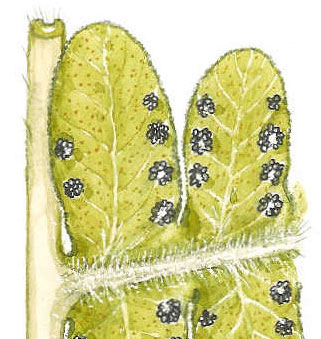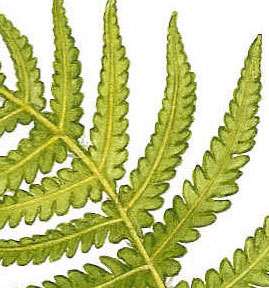|
Hardy Fern Home All Ferns Fern Families ��Aspleniaceae ��Blechnaceae ��Dennstaedtiaceae ��Dryopteridaceae ��Lygodiaceae ��Osmundaceae ��Polypodiaceae ��Pteridaceae ��Thelypteridaceae ��Woodsiaceae Fern Genera ��Adiantum ��Arachniodes ��Aspidotis ��Asplenium ��Astrolepis ��Athyrium ��Blechnum ��Cheilanthes ��Cryptogramma ��Cyrtomium ��Cystopteris ��Dennstaedtia ��Deparia ��Diplazium ��Dryopteris ��Gymnocarpium ��Lygodium ��Matteuccia ��Onoclea ��Oreopteris ��Osmunda ��Pellaea ��Phegopteris ��Pleopeltis ��Polypodium ��Polystichum ��Pteridium ��Pteris ��Pyrrosia ��Thelypteris ��Woodsia ��Woodwardia |
| Thelypteridaceae | ||
|
Indument of transparent needlelike hairs, general absence of blade scales, stipe vasculature with two crescent-shaped bundles, generally 1-pinnate to pinnate-pinnatifid blades. Here 3
genera. | ||
| Oreopteris | ||
|
Etymology
Greek: From oreos, mountain, + pteron, wing, describing the pinnae. But note that pteris was used by ancient Greeks to describe all ferns. Oreopteris is a fern of the mountainous regions.
Description
Rhizome: erect, triangular scales.
Frond: deciduous, monomorphic. Stipe: grooved above (not continuous), scaly, vascular bundles: 2, crescent-shaped. Blade: 1-pinnate to pinnate-pinnatifid, lanceolate to ovate, transparent needlelike hairs, glandular. Pinnae: shortened towards the base, becoming extremely small, costae grooved above or not, veins free. Sori: round or oblong, near the margins, indusium: small or absent.
Distinctive Characteristics
Yellow glands on lower surface, hairs on costae, pinnae becoming tiny at the base.
|
|
|
| Phegopteris | ||
Beech fern | ||
|
Etymology
Greek: phegos, beech + pteris, fern. The original name for Phegopteris connectilis was Polypodium phegopteris, the beech fern.
Description
Rhizome: long-creeping, ovate scales.
Frond: deciduous, monomorphic. Stipe: straw-colored at base, scales tan, lanceolate, below, and pointed hairs on both sides, vascular bundles: 2, crescent-shaped. Blade: pinate-pinnatifid, triangular to ovate, transparent needlelike hairs and spreading, ovate-lanceolate scales on rachis below. Pinnae: base fused to rachis, and often connected by wings, costae not grooved, spreading, ovate-lanceolate scales below, veins free, simple or forked. Sori: round to oblong, beyond the middle to submarginal, indusium: absent, sporangia: tan.
Distinctive Characteristics
The broad connection of the pinnae along the rachis (adnate) and winged tissue between adjacent pinnae is distinctive.
|
|
|
| Thelypteris | ||
Female fern | ||
|
Etymology
From the Greek. Thelys means female, + pteris, the word for ferns in general.
Description
Rhizome: long-creeping, triangular scales.
Frond: deciduous, monomorphic or somewhat dimorphic. Stipe: scaly, vascular bundles: 2, crescent-shaped. Blade: 1-pinnate to pinnate-pinnatifid, lanceolate to ovate, transparent needlelike hairs, sometimes glandular. costae grooved above, discontinuous with the rachis, veins free. Sori: round or oblong, medial to supramedial or elongate along veins, indusium: reniform, occasionally ephemeral, at a sinus.
Distinctive Characteristics
Members of the genus are pinnate with deeply lobed pinnae, have two vascular bundles, sori with a kidney-shaped, short-lived indusium, and needle-like, translucent or white hairs on the lamina, rachis, stipe.
|
||


